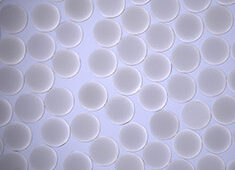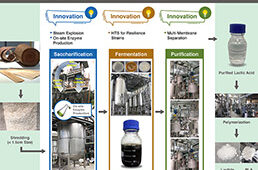Professor Donald Sadoway and Materials Processing Center Research Affiliate David Bradwell observe one of their small test batteries in the laboratory. The battery itself is inside the heavily insulated metal cylinder at center, which heats it to 700 C. Photo: Patrick Gillooly/MIT |
The
biggest drawback to sources of clean, renewable energy is their intermittency:
The wind doesn’t always blow, the sun doesn’t always shine, and so the power
they produce may not be available at the times it’s needed. A major goal of
energy research has been to find ways to help smooth out these erratic
supplies.
New
results from an ongoing research program at the Massachusetts Institute of
Technology (MIT), reported in the Journal of the American Chemical Society,
show a promising technology that could provide that long-sought way of leveling
the load—at far lower cost and with greater longevity than previous methods.
The system uses high-temperature batteries whose liquid components, like some
novelty cocktails, naturally settle into distinct layers because of their
different densities.
The
three molten materials form the positive and negative poles of the battery, as
well as a layer of electrolyte—a material that charged particles cross through
as the battery is being charged or discharged—in between. All three layers are
composed of materials that are abundant and inexpensive, explains Donald
Sadoway, the John F. Elliott Professor of Materials Chemistry at MIT and the
senior author of the new paper.
“We
explored many chemistries,” Sadoway says, looking for the right combination of
electrical properties, abundant availability, and differences in density that
would allow the layers to remain separate. His team has found a number of
promising candidates, he says, and is publishing their detailed analysis of one
such combination: magnesium for the negative electrode (top layer), a salt
mixture containing magnesium chloride for the electrolyte (middle layer), and
antimony for the positive electrode (bottom layer). The system would operate at
a temperature of 700 C, or 1,292 F.
In
this formulation, Sadoway explains, the battery delivers current as magnesium
atoms lose two electrons, becoming magnesium ions that migrate through the
electrolyte to the other electrode. There, they reacquire two electrons and
revert to ordinary magnesium atoms, which form an alloy with the antimony. To
recharge, the battery is connected to a source of electricity, which drives
magnesium out of the alloy and across the electrolyte, where it then rejoins
the negative electrode.
The
inspiration for the concept came from Sadoway’s earlier work on the
electrochemistry of aluminum smelting, which is conducted in electrochemical
cells that operate at similarly high temperatures. Many decades of operation
have proved that such systems can operate reliably over long periods of time at
an industrial scale, producing metal at very low cost. In effect, he says, what
he figured out was “a way to run the smelter in reverse.”
Over
the last three years, Sadoway and his team—including MIT Materials Processing
Center Research Affiliate David Bradwell MEng ’06, PhD ’11, the lead author of
the new paper—have gradually scaled up their experiments. Their initial tests
used batteries the size of a shot glass; they then progressed to cells the size
of a hockey puck, three inches in diameter and an inch thick. Now, they have
started tests on a six-inch-wide version, with 200 times the power-storage
capacity of the initial version.
The
electric utility companies that would ultimately be the users of this
technology, Sadoway says, “don’t care what the stuff is made of, or what the
size is. The only question is what’s the cost of storage” for a given amount of
power. “I can build a gorgeous battery to a NASA price point,” he says—but when
cost is the primary driver, “that changes the search” for the best materials.
Just based on the rarity and cost of some elements, “large sections of the
periodic table are off limits.”
The
team is continuing to work on optimizing all aspects of the system, including
the containers used to hold the molten materials and the ways of insulating and
heating them, as well as ways of reducing the operating temperature to help cut
energy costs. “We’ve discovered ways to decrease the operating temperature
without sacrificing electrical performance or cost,” Sadoway says.
While
others have researched similar liquid-battery systems, Sadoway says he and his
team are the first to produce a practical, functional storage system using this
approach. He attributes their success in this partly to the unique mix of
expertise in a place like MIT: “People in the battery industry don’t know
anything about electrolytic smelting in molten salts. Most would think that
high-temperature operation would be inefficient.”
Sadoway,
along with Bradwell, has founded a company to bring this technology to
commercialization, and is on sabbatical this year working with the company,
Liquid Metal Battery Corp. “If this technology succeeds,” he says, “it could be
a game-changer” for renewable energy.





